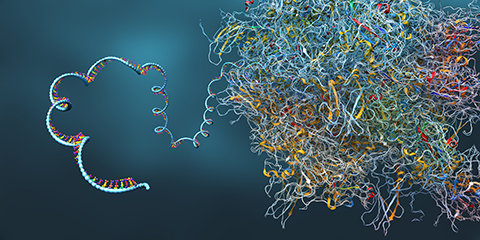From the journals: JBC
Functionally clustered mRNAs are translated together. Phase separation promotes H3K4 methylation. Promoting axon regeneration. Read about papers on these topics recently published in the Journal of Biological Chemistry.
Functionally clustered mRNAs are translated together
A cell adapts its proteome to environmental conditions via the regulation of mRNA translation. Translation regulation in eukaryotes depends on not only mRNA abundance and degradation but also a conserved set of 11 basal translation initiation factors and formation of a closed-loop structure connecting the 5′ and 3′ mRNA ends; however, results of recent studies showed that some mRNAs, instead of being translated or degraded, were stored in localized cytosolic condensates called P-bodies, and did not bind classical translation initiation factors until a cell stressor was introduced. Researchers are still debating over the mechanisms cells use to define which mRNAs will be translated and when.

In a recent paper in the Journal of Biological Chemistry, Christopher Kershaw at the Manchester Centre for Genomic Medicine, Michael Nelson at the University of Manchester and colleagues at the University of Sheffield and biotech companies Peak Proteins and Envision Pharma Group describe their continuing investigations into patterns of mRNA interaction with translation initiation factors. Using RNA immunoprecipitation-sequencing, or RIP-seq, and gene ontology, they identified seven clusters of mRNAs based on interaction with the 43S translation initiation complex, the closed-loop complex and mRNA decay proteins.
While they noted that mRNAs stored in P-bodies bind translation repressors and mRNA decay proteins Pat1 and Lsm1, they also found that nearly half of the proteome is translated from two clusters of mRNAs despite these clusters displaying poor interaction with most translation initiation factors. Furthermore, RNAs that interacted with components of the closed loop complex had variable translation rates, raising questions about the need for this structure.
The authors conclude that their results support the RNA regulon model, which states that functionally related proteins are coordinately regulated as posttranscriptional operons. As interaction with translation initiation factors may not be the best predictor of high translation, it is likely that factors such as 5′-UTR length may also play a role in defining the translation efficiency of mRNAs in normal or stress conditions.
Phase separation promotes H3K4 methylation
Histone H3 lysine 4, or H3K4, methylation patterns make up part of the histone code that determines whether and how efficiently a given stretch of DNA can be transcribed. In humans, H3K4 methylation is, in part, regulated by the mixed-lineage leukemia, or MLL, family of proteins, with multiple methylation, in particular, being dependent on the MLL1 core complex. Scientists have previously shown that formation of the MLL1 core complex is highly concentration- and temperature-dependent; however, at normal human body temperature, formation is energetically disfavored, suggesting protein subunit concentration must overcome this thermodynamic barrier.
In a recent article in the Journal of Biological Chemistry, Kevin Namitz and colleagues at the State University of New York Upstate Medical University and Pennsylvania State University describe how phase separation could facilitate formation of the MLL1 complex at body temperature. Using enzyme kinetics and differential interference contrast and fluorescence microscopy techniques, they showed that hydrodynamic changes resulting from macromolecular crowding led to liquid–liquid phase-separated droplets of proteins with highly disordered regions, such as MLL1. Furthermore, these droplets displayed high enzymatic H3K4 methylation activity associated with a highly active oligomeric scaffold of the MLL1 core complex.
These findings suggest that phase separation is a principle effector of conformational changes that lower the KM of the reaction and allow formation of the active MLL1 core complex scaffold at body temperatures. Future studies will be necessary to address how phase separation can promote H3K4 methylation activity.
Promoting axon regeneration
After neuron injury, the axon typically regenerates only slightly or not at all, leading to permanent neurological damage. Scientists have shown that an inhibitory protein, NogoA, contains two domains that prevent axon regeneration, and when researchers delete these domains in mice, leaving only the amino-terminal domain, regeneration and recovery from axon injury improve. However, when researchers also delete the amino-terminal domain, they do not see improved repair, raising the question of whether organisms naturally produce such an isolated amino-terminal fragment.
In their new study published in the Journal of Biological Chemistry, Yuichi Sekine and colleagues at Yale School of Medicine and Kyoto Pharmaceutical University investigated the production and role of the NogoA amino-terminal fragment in axon regeneration. They used Western blotting and a series of mutations to show that this fragment was produced in the forebrain by cleavage of full-length NogoA, and its levels increased after axons were severed in cortical neuron cell culture andin the spinal cord after trauma.
The researchers also found that when administered outside a cell, the NogoA fragment did not affect axonal regeneration, but when overexpressed within the cell it stimulated regeneration. Finally, to determine the mechanism involved, the authors used immunoprecipitation to determine interacting proteins and identified the NogoA fragment complexed with HSPA8, a heat shock protein. In further experiments, they showed that HSPA8 was also involved in axonal regeneration, perhaps via enhanced protein refolding.
These data identify a novel pathway by which NogoA cleavage and chaperone protein HSPA8 could mediate axonal regeneration. It remains to be seen whether this pathway can be therapeutically targeted for better regeneration in living organisms.
Enjoy reading ASBMB Today?
Become a member to receive the print edition four times a year and the digital edition monthly.
Learn moreGet the latest from ASBMB Today
Enter your email address, and we’ll send you a weekly email with recent articles, interviews and more.
Latest in Science
Science highlights or most popular articles

The science of staying strong
Muscles power every movement, but they also tell the story of aging itself. Scientists are uncovering how strength fades, why some species resist it and what lifestyle and molecular clues could help preserve muscle health for life.

Bacteriophage protein could make queso fresco safer
Researchers characterized the structure and function of PlyP100, a bacteriophage protein that shows promise as a food-safe antimicrobial for preventing Listeria monocytogenes growth in fresh cheeses.

Building the blueprint to block HIV
Wesley Sundquist will present his work on the HIV capsid and revolutionary drug, Lenacapavir, at the ASBMB Annual Meeting, March 7–10, in Maryland.

Gut microbes hijack cancer pathway in high-fat diets
Researchers at the Feinstein Institutes for Medical Research found that a high-fat diet increases ammonia-producing bacteria in the gut microbiome of mice, which in turn disrupts TGF-β signaling and promotes colorectal cancer.

Mapping fentanyl’s cellular footprint
Using a new imaging method, researchers at State University of New York at Buffalo traced fentanyl’s effects inside brain immune cells, revealing how the drug alters lipid droplets, pointing to new paths for addiction diagnostics.

Designing life’s building blocks with AI
Tanja Kortemme, a professor at the University of California, San Francisco, will discuss her research using computational biology to engineer proteins at the 2026 ASBMB Annual Meeting.

